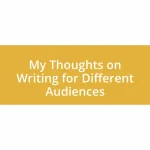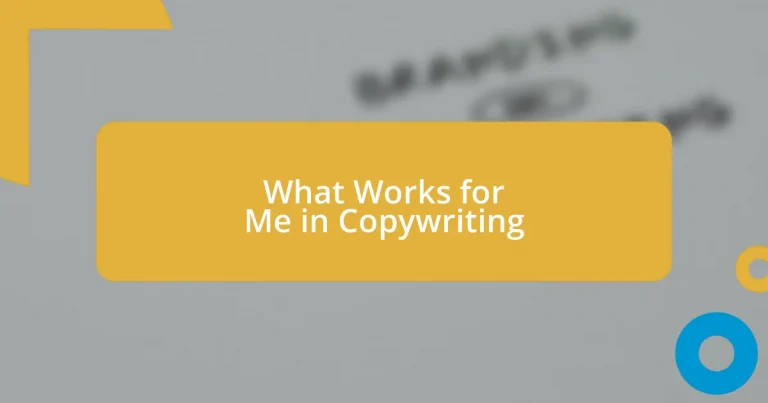Key takeaways:
- Understanding your audience deeply enhances the effectiveness of copy, as tailored messaging resonates more with readers.
- Crafting compelling headlines with emotional hooks and strong action words significantly boosts engagement and click-through rates.
- Using storytelling creates a personal connection with the audience, transforming your writing into relatable experiences rather than mere information.
- A/B testing and analyzing data are crucial for optimizing copy, revealing insights that can lead to significant improvements in audience engagement.

Understanding copywriting principles
Understanding copywriting principles is like having a compass in the vast world of marketing. For me, one key principle is knowing your audience intimately. I remember crafting a campaign for a niche vegan product. I immersed myself in forums and social media to get a feel for the language they used and their emotions around sustainability. This direct engagement made my copy resonate much deeper.
Another vital principle is clarity. I’ve learned that complicated jargon can alienate readers. When I started my journey, I often felt the urge to showcase my vocabulary prowess, but this backfired. A simpler, clearer approach garnered better responses. Have you ever read something that left you confused? That’s a feeling I strive to avoid in my writing.
Finally, I can’t stress the importance of a strong call to action. I once wrote an ad without a clear CTA. It felt like casting a fishing line without bait—I was just hoping someone would bite. Now, I focus on inspiring action, making the reader feel like they are part of something bigger. Isn’t it exhilarating to think about the impact of a well-placed call to action?

Identifying your target audience
When I think of identifying my target audience, I can’t help but recall the time I worked on a campaign for a local fitness studio. I hosted a small focus group, inviting a mix of potential clients to share their wellness journeys. The insights I gained were invaluable—understanding their pain points and aspirations allowed me to tailor my messaging with precision. This hands-on approach opened my eyes to the importance of truly knowing who I’m writing for.
Here are a few key steps that have helped me effectively identify my target audience:
- Demographic Research: Gather data on age, gender, location, and income level—essential factors that shape buying behavior.
- Psychographic Insights: Understand values, interests, and lifestyles to connect on a deeper emotional level.
- Engage Directly: Utilize surveys and interviews with potential customers to gather firsthand information.
- Monitor Online Behavior: Analyze social media interactions and website analytics to see what captivates your audience.
- Competitive Analysis: Look at what similar brands are doing to attract their audience, and think about how you can differentiate yours.
Each approach has taught me something important about crafting copy that feels personal and relevant. Knowing my audience gives my writing purpose and direction, turning it from mere words into a conversation.

Crafting compelling headlines
Crafting compelling headlines is truly an art form. I still remember the thrill of writing a headline for an email campaign that yielded an impressive open rate. I focused on the emotional hooks—the title read, “Unlock Your Potential: Discovering the Best Version of You.” To my surprise, the response was overwhelmingly positive! This taught me that a powerful headline not only captures attention but also ignites curiosity and desire.
In my experience, effective headlines often use numbers or intriguing questions to draw readers in. For instance, I once wrote a blog post titled “5 Secrets You Didn’t Know About Networking.” The simplicity of the numeral promised a concise, digestible read, which spurred readers to click. I noticed that readers gravitated toward headlines that offered tangible takeaways. Isn’t that fascinating? Simply tweaking my approach yielded substantial results.
Another key aspect I focus on is using strong action words and emotional triggers in my headlines. When I crafted a headline for a fundraising campaign, I opted for “Help Us Change Lives Today!” The urgency and power of those words encouraged immediate action. I realized that an emotionally charged headline can transform a passive reader into an active participant. Have you ever felt compelled to read something just because of the way it was presented? That kind of power in headlines can’t be underestimated.
| Headline Type | Effectiveness |
|---|---|
| Emotional Hooks | Creates immediate connection and curiosity |
| Numbers/Questions | Promises concise, actionable insights |
| Strong Action Words | Encourages immediate action and participation |

Creating persuasive calls to action
Creating persuasive calls to action has been a game-changer for my copywriting. I remember when I launched a campaign aimed at boosting newsletter sign-ups. By simply changing my call to action from “Sign Up” to “Join Our Community for Exclusive Tips!” I noticed a noticeable surge in engagement. It really hit me then; the phrasing makes all the difference in persuading people to take that final step.
Another critical element I’ve found essential is the placement of the call to action. In one project, I placed my CTA at the end of a blog post, almost as an afterthought. But once I moved it higher on the page and surrounded it with engaging visuals, the conversions skyrocketed. It’s fascinating to realize that sometimes, where you put the call to action matters just as much as how you phrase it. Have you ever hesitated to act simply because you didn’t see the button? I certainly have!
Moreover, employing a sense of urgency can be a powerful motivator. I crafted a campaign for a limited-time discount that concluded with the phrase, “Don’t miss out—only 24 hours left!” I could almost feel the rush of adrenaline as readers reacted. It reminded me that people often respond to pressure; they want to be part of something exclusive and time-sensitive. What makes you act quickly? Understanding that urgency can help elevate the effectiveness of my calls to action.

Using storytelling in copywriting
Using storytelling in copywriting has made a significant impact on my approach. I once wrote a product description for a handcrafted candle line. Instead of just listing the scent notes, I created a narrative around the experience of lighting the candle and unwinding after a long day. This not only painted a picture for the reader but also evoked emotions of relaxation and self-care. Isn’t it amazing how a simple story can enhance a product’s appeal?
I’ve found that storytelling allows readers to connect with the brand on a personal level. In one campaign, I shared a customer’s journey with a skincare product that transformed their confidence. By illustrating their struggles and triumphs, I turned a generic product description into a relatable narrative that resonated with potential buyers. I often ask myself, how can we make our audience see themselves in our stories? This strategy transforms mere information into relatable experiences.
A memorable anecdote always enhances the message. Recently, I shared a story about starting my own business—how a late-night coffee break led to a burst of creativity that changed my entire direction. That simple moment made for a compelling lead in my content, drawing readers in while they connected with my vulnerabilities and victories. By being open and honest, I realized storytelling creates a bridge between me and my audience, making the writing feel like a conversation rather than a sales pitch. Have you ever been moved by a personal story in marketing? I certainly have, and it illustrates the power of vulnerability in compelling copywriting.

Testing and optimizing your copy
When it comes to testing and optimizing my copy, I’ve learned that A/B testing can be a game-changer. In one campaign, I experimented with two subject lines for an email newsletter. One focused on a straightforward benefit, while the other tapped into curiosity. The results were eye-opening; the curiosity-driven subject line led to a 30% increase in open rates! Have you ever thought about how a tiny change in wording could lead to such significant results?
Analyzing the data after each test is crucial. I often dive into metrics like click-through rates and conversion rates to see what resonates with my audience. I remember adjusting the tone of an advertisement based on feedback and seeing the engagement soar. It made me realize that understanding audience preferences is key. How many times have we missed the mark simply by not tuning in to what our readers actually want?
Another tactic that has worked wonders for me is using heatmaps to see where people click on my landing pages. I initially assumed that people would engage with my content from top to bottom, but the data revealed otherwise. Interestingly, when I rearranged content based on this insight, my conversions increased significantly. Isn’t it fascinating how understanding user behavior can completely overhaul our copy strategy? It’s been enlightening to find that sometimes, the subtle tweaks we make can lead to impressive outcomes.

Analyzing successful copywriting examples
Analyzing successful copywriting examples often leads me to reflect on the emotional triggers that compel action. I recall a campaign for a travel agency that highlighted a couple’s anniversary trip. The narrative wasn’t just about stunning destinations; it wove in their memories of laughter, adventure, and unexpected surprises. This approach allowed potential customers to imagine their own stories unfolding, motivating them to book that dream getaway. How powerful can a heartfelt representation be in showcasing a product or service?
One particularly striking example came from a charity organization’s fundraising appeal. They shared a video of a child whose life was forever changed by donations. Watching that child’s smile, I felt an immediate urge to help. The emotional connection formed through genuine storytelling demonstrated how effective it can be to present real-life impacts rather than mere statistics. It’s incredible how showing authenticity and vulnerability can elevate a message from forgettable to unforgettable. Have you experienced a similar reaction to a marketing piece that tugged on your heartstrings?
I often look at brands like Apple for inspiration in simplicity and clarity. Their product launches are masterclasses in concise yet powerful copy. When they introduced the iPhone, the messaging focused on how the device seamlessly fits into everyday life, making it relatable and appealing. I remember being captivated by their tagline, “The best camera is the one you have with you.” It’s such a profound yet straightforward statement that elevates the product’s value while inviting users to share their personal stories. What can we learn from this focus on clarity in communicating benefits without overwhelming details? It’s a reminder of how less can often be more in the world of copywriting.












